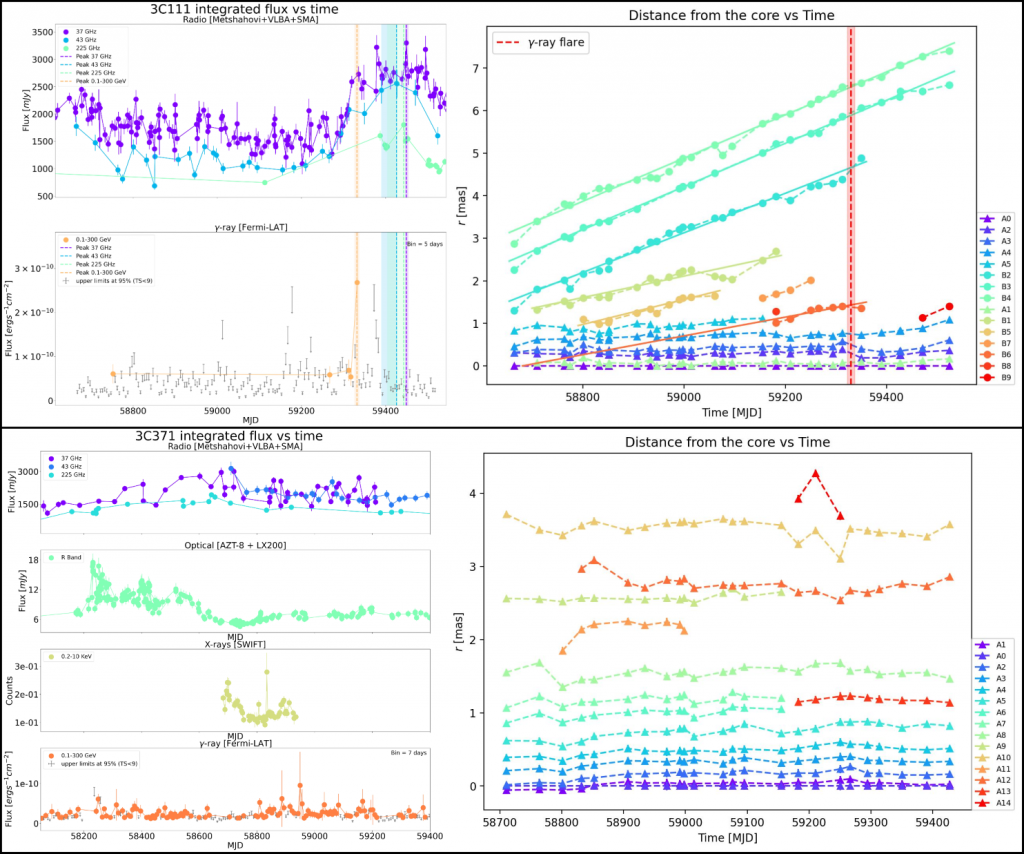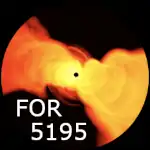P1: Jet Physics on Event Horizon Scales and Beyond
The Event Horizon Telescope (EHT) has repeatedly proven to be capable of imaging microarcsecond-scale structures near supermassive black holes. In the prominently featured case of Messier 87 and Sagittarius A*, this has led to famous depictions of black hole shadows and images of the mass accretion region with resolutions of roughly ten Schwarzschild radii. Using the same interferometric array and frequencies, other active galaxies at bigger distances or with smaller black-hole masses can be observed on scales of hundreds of Schwarzschild radii, probing the jet-launching, acceleration and collimation zone. This has recently been demonstrated for the case of 3C 279. In addition, only four other AGN were main targets in the 2017 and 2018 EHT observing sessions, three of which will be analysed in this project: NGC 1052, Centaurus A, and 4C+01.28. We combine: (I) imaging these AGN jets with highest-resolution VLBI observations at 1 mm (EHT) and 3 mm (GMVA), and (II) modelling these observations with state-of-the-art numerical general relativistic magnetohydrodynamic (GRMHD) simulations and general relativistic radiative transfer (GRRT) calculations.

Credit: Christian Fromm
P2: Jet Lamp-Post Models for Radio-Loud Active Galactic Nuclei
X-ray observations of accreting black holes routinely reveal relativistic reflection features from the innermost regions around the black hole which allow us to measure its spin and to probe the location of the primary source of X-rays, the “corona”. Detailed observations of radio quiet objects have consolidated our view of a compact corona close to the black hole. Its nature is still strongly debated. One possible interpretation connects it to the base and launching region of a sub-luminous jet. While most sources analysed to date have been Seyfert galaxies, recent high-quality data from radio-loud Active Galactic Nuclei (AGN) have also shown evidence for relativistic reflection.
We will investigate the location and nature of the corona in AGN with relativistic jets. For the first time, we will analyse a sample of radio-loud AGN with a physically motivated relativistic reflection model, supported by a system inclination that is constrained from VLBI measurements. This approach will allow us to measure the location and size of the corona, which will be compared to GRMHD simulations from P1 to address the long-standing question if the X-ray corona is the base of the relativistic jet.

Credit: Alexey Nekrasov

P3: Flaring and Time-Dependent Modelling of Blazars
One of the key characteristics of blazars is their strongly variable emission. Their flux varies by up to orders of magnitude throughout the entire electromagnetic spectrum down to time scales of minutes. The gamma-ray band is of particular interest as it often dominates the total energy output of blazars. Features imprinted in the light curves are likely related to changes in the underlying particle distributions and allow us to probe different physical mechanisms.
In this project we will study variability properties of blazars in the gamma-ray band and multi-frequency correlations. We will explore the constraints on phenomenological models of acceleration and substructure in blazars. The analysis and interpretation of blazar gamma-ray variability opens an unlimited discovery space challenging our theoretical understanding of the black-hole jet phenomenon. We specifically address the precision diagnosis of the fastest gamma-ray variability observed across a wide energy band up to very high energies (VHE, > 100 GeV) to test models of jet substructures and radiation mechanisms by applying novel methods. We also target the jet-disk connection by investigating statistical broadband variability properties.

Copyright: ESA/ATG medialab
P4: Millimetre-VLBI Studies of Gamma-Ray Bright Radio Galaxies
Nearby radio galaxies are ideal laboratories to study the physical processes occurring in the vicinity of supermassive black holes. In radio galaxies, unlike in blazars, projection and relativistic effects have a mild impact on the observed jet emission, which enables us to more easily infer the intrinsic jet properties and to probe emitting regions which would be, otherwise, hidden. In this project we will conduct millimetre-VLBI studies of radio galaxies detected by the Fermi-LAT telescope at gamma-ray energies, with the aim of characterizing the jet internal structure, pinpointing the high-energy emission sites, and modelling the broadband emission. The novelty of our approach resides in the possibility to directly constrain the fundamental parameters of the relativistic plasma, on the exact scales where the gamma-ray emission is thought to originate. While previous analyses have been limited to a few case studies, our goal is to obtain a broad overview of the high-energy emission processes in relation to the accretion properties and the jet power.

P5: Jet Composition under Scrutiny
The goal of this project is to shed light on the plasma composition in AGN jets that is a long- standing question since the seminal work by Blandford and Znajek as early as 1977. Although a basic framework for describing extragalactic jets exists, their unknown plasma composition has always rendered the interpretation of observational data and the understanding of their launching mechanism difficult.
This project will combine two distinct, but complementary approaches to the problem, that are in fact highly interrelated. That is (i) modelling the jet plasma dynamics by relativistic MHD simulations, and (ii) modelling of the spectral energy distribution from high energy particles in the jet. Sub-project (ii) will benefit from the realistic physical modelling of the jet dynamics from its launching area to (almost) pc scales including resistive effects as e.g. reconnection flares, and sub-project (i) may apply more realistic cooling of the jet plasma.

Credit: Ravi Pratab Dubey
P6: Large-Scale Blazar Jets: Clues on High-Energy Emission from Low-Frequency Radio Observations
More than 100 AGN jets have been imaged with arcsecond resolution in the optical and X- ray band. In the case of low-power FR I sources, the X-ray jet emission can generally be interpreted as an extension of the radio synchrotron spectrum. In contrast to this, the radio, optical and X-ray broadband spectra of FR II jets clearly show that other emission processes are at play. Originally, inverse-Comptonisation of CMB photons was suggested. This model requires bulk relativistic motion on kiloparsec scales (which is difficult to observe) and an electron energy distribution extending down to Lorentz factors smaller than 100, which is lower than the energy regimes traced by GHz instruments like the VLA. Very recently, first results of high-resolution LOFAR observations of AGN jets involving international baselines at hundreds of MHz found radio flux densities in one quasar well below the values estimated by extrapolating the GHz spectra and thus falling short of explaining the observed X-ray knot emission in terms of the IC/CMB model. In this project, we will perform a systematic LOFAR study of the long-wavelength radio emission of quasar jets on kiloparsec scales and combine this with shorter-wavelength radio and higher-energy optical and X-ray broadband spectral data to test the IC/CMB and alternative emission models. We will further develop and optimize high-resolution imaging techniques at the low and ultra-low radio frequencies in total and linearly-polarized intensity with LOFAR-VLBI techniques to measure magnetic-field geometries and constrain jet-composition and emission models.
P7: Jet Feedback on Groups and Galaxy Clusters
The cosmological concordance model provides an astonishing match to data of large-scale cosmological surveys, but on smaller scales – where baryonic effects start to become dominant – the situation is less clear. In particular, the halo mass and galaxy luminosity distributions differ significantly so that the star conversion efficiency has to be a strong function of halo mass. Gas is less efficiently converted to stars towards the scale of galaxy groups and clusters. The interplay of cooling gas, subsequent star formation, and nuclear activity appears to be tightly coupled to a self-regulated feedback loop that may explain this cosmological conundrum. The main goal of this project aims at studying the non-thermal aspect of the active galactic nucleus (AGN) feedback loop in the vicinity of the jet and compares observed and synthetic radio emission to calibrate feedback. To this end, this project uses LOFAR data (in particular newly available high-resolution long-baseline data) and state-of-the-art cosmological magneto-hydrodynamical simulations with cosmic ray and AGN jet physics of galaxy groups and clusters to explore how jets transfer energy and momentum to the intra-cluster medium (ICM) and regulate cooling and star formation. Results from this project serve as large-scale constraints to small-scale relativistic jet models that will be pursued in this proposed research unit in particular by the Mercator fellow Manel Perucho. Our main research questions are: 1. How is feedback energy transferred from the AGN jets to the cooling ICM and which observational signatures demonstrate this unambiguously? 2. Can cosmic ray heating from AGN jets reproduce the observed bimodality of the distribution of cool core and non-cool core clusters? 3. Which parameters determine the morphology of AGN jets (luminosity, environment, or composition) and how can we relate this to feedback?


Associated Junior Research Group: Blazars as Probes of Fundamental Physics and Intergalactic Magnetic Fields
Electromagnetic AGN emission provides a unique test bed to study the propagation of photons over cosmological distances. In particular, high-energy gamma rays produced in jets can interact with intergalactic radiation fields such as the extragalactic background light (EBL) and produce electron-positron pairs. The EBL is composed of star light and light reprocessed to infrared wavelengths through the interaction with dust in the interstellar medium integrated over the age of the Universe. Due to strong foreground emission in the solar system, it is extremely difficult to directly measure the EBL. Instead, the amount of gamma-ray absorption can reveal the EBL intensity as a function of cosmic time and wavelength. Gamma-ray observations of blazar jets can therefore be used to constrain the cosmic star formation history.
Additionally, the electron-positron pairs can inverse-Compton scatter with photons of the EBL and cosmic microwave background, with the scattered photon energy ending up in the gamma-ray band. This process can then trigger an electromagnetic cascade as the up-scattered photons again produce pairs. The spectral, temporal and spatial signature of this cascade emission will depend on the intergalactic magnetic field (IGMF) since it deflects the electrons and positrons. Gamma-ray observations of the cascade could therefore be used to infer the strength of the IGMF in cosmic voids or to probe whether the IGMF is of astrophysical origin (through the galactic plasma outflows “polluting” the intergalactic medium) or instead produced in primordial phase transitions.
Gamma-ray propagation could also be affected through the interaction with yet undiscovered fundamental particles. In particular, gamma rays could oscillate into axions or axion-like particles (ALPs) in the presence of external magnetic fields. These types of particles are well motivated dark matter candidates and in the case of the axion additionally explain the non-observation of the electric dipole moment of the neutron (the so-called strong CP problem). The photon-axion/ALP interaction would lead to unique observational signatures in gamma-ray spectra of AGN such as energy-dependent spectral distortions or the reduction of the gamma-ray opacity caused by EBL interactions.

DFG Research Unit (Forschungsgruppe) FOR 5195 – Relativistic Jets in Active Galaxies
Funded by the Deutsche Forschungsgemeinschaft (DFG, German Research Foundation)
